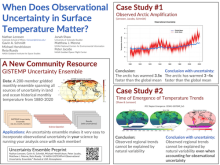When does observational uncertainty in surface temperature matter?
Nathan
Lenssen
Colorado School of Mines
Poster
NASA's historical surface temperature product, GISTEMP, combines measurements of sea surface temperature and land surface air temperature to estimate how temperature has changed on Earth since 1880. A new GISTEMP uncertainty ensemble combines all known sources of uncertainty in these measurements to determine the best estimate as well as the likely interval for surface temperature in the global average as well as on a latitude-longitude grid. This uncertainty ensemble makes it easy to incorporate the uncertainty in surface temperature in subsequent analyses.
This talk will details this new uncertainty ensemble and apply it to two classic climate change questions: the emergence of trends from internal variability and the observed rate of warming of the Arctic relative to the global mean. These examples provides situations where observational uncertainty can change the interpretation of key scientific results used in IPCC-type reports. We close with some recommended best practices for incorporating observational uncertainty in climate change and variability research.
This talk will details this new uncertainty ensemble and apply it to two classic climate change questions: the emergence of trends from internal variability and the observed rate of warming of the Arctic relative to the global mean. These examples provides situations where observational uncertainty can change the interpretation of key scientific results used in IPCC-type reports. We close with some recommended best practices for incorporating observational uncertainty in climate change and variability research.

Poster file
lenssen-nathan-confronting-poster.pdf
(2.42 MB)
